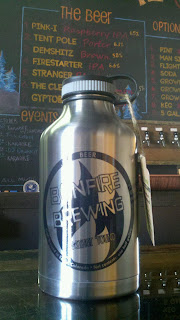The Growler: Part 1 The Past
 ***(Update - Part 2 with responses from Greg Koch, Joe Mohrfeld, and Matt Thrall is here)***
***(Update - Part 2 with responses from Greg Koch, Joe Mohrfeld, and Matt Thrall is here)***
The growler has been a loyal companion of mine ever since attending that first Colorado party where someone brought this 64oz vessel of fresh beer straight from the brewery. I thought the concept was perfect, a reusable large container for transporting the freshest beer to my house straight from the brewery. For the past decade I've collected dozens of growlers and enjoyed surprising friends with fresh and/or rare treats from breweries across the country. I thought everyone loved growlers and enjoyed their delicious contents until earlier this week when I read an article entitled Why Beer Growlers are Bad for your Brew. I was pretty surprised by this one sided pretty biased article so I decided to do some research on the subject. Join me as we embark on a journey of growler history and explore the different opinions on the growler's role in enjoying fresh beer in this two part series.
Part 1: The history of the Growler
 |
| Image from Jess Kidden |
The growler started its humble beginnings in the mid 1800’s before the popularity of pre-filled bottles and cans. If a customer wanted beer outside of a saloon, they would fill a container with beer. The containers ranged from pitchers to jars to jugs and were made of various materials such as glass metal and pottery. The most common container was a two quart galvanized pail. The vessels were called growlers. Growler fills were sold as a “pint” and were filled with close to a quart of beer and an equal part of foam. An early 20th century growler fill was commonly 5-15 cents.
 |
| Image from Jess Kidden |
The origin of the word “growler” has many theories. The most popular theory is that it was
named from the growling sounds the pail would make as CO2 escaped through the lid. Others believe it’s the rumbling stomachs of the workers in anticipation for their beer during breaks. Another theory suggests that it was the constant conflict between the bartender only filling the growler half full and the customer wanting a full pour of beer, causing the “growling”.
Children were employed by their parents or workers in the community to buy growlers and deliver then home or to the workplace during lunch breaks. This practice was coined “rushing the growler”. This practice was abolished thanks to the Prohibition.


The advent of the modern day growler started in 1989 by Otto Brothers Brewery in Wilson, Wyoming. The brewery was not yet bottling their beer but wanted to give their customers a means of bringing their beer home with them. Father Otto suggested the use of “growlers” that he remembered from his childhood. They decided on glass “moonshine” jugs, slapped their logo on the jug, and the rest is history. They changed the name of their brewery to Grand Teton Brewing in 2000.

 The growler has not changed much since in the last 20+ years. Most growlers are 64oz. glass jugs of brown glass with a white metal twist off cap. Some breweries use clear class. A few places will even make growlers with blue and green glass. There are also rounded 2 liter versions with clampdown ceramic tops like those used at Stone Brewing and Russian River Brewing in California. Some have fancy metal handles like those used at Pikes Peak Brewing in Monument, Colorado. A few breweries such a Bonfire Brewing in Eagle, Co, and Stone Brewing have started using stainless steel “canteens” or “flasks”.
The growler has not changed much since in the last 20+ years. Most growlers are 64oz. glass jugs of brown glass with a white metal twist off cap. Some breweries use clear class. A few places will even make growlers with blue and green glass. There are also rounded 2 liter versions with clampdown ceramic tops like those used at Stone Brewing and Russian River Brewing in California. Some have fancy metal handles like those used at Pikes Peak Brewing in Monument, Colorado. A few breweries such a Bonfire Brewing in Eagle, Co, and Stone Brewing have started using stainless steel “canteens” or “flasks”.Part II in this series will discuss the benefits and disadvantages of the growler and will also look into possible alternatives.
Resources:

